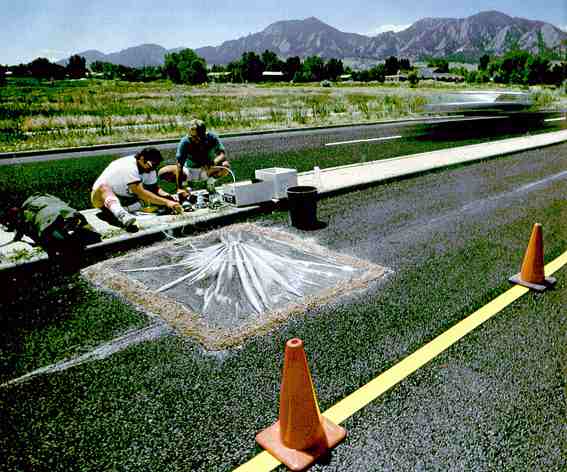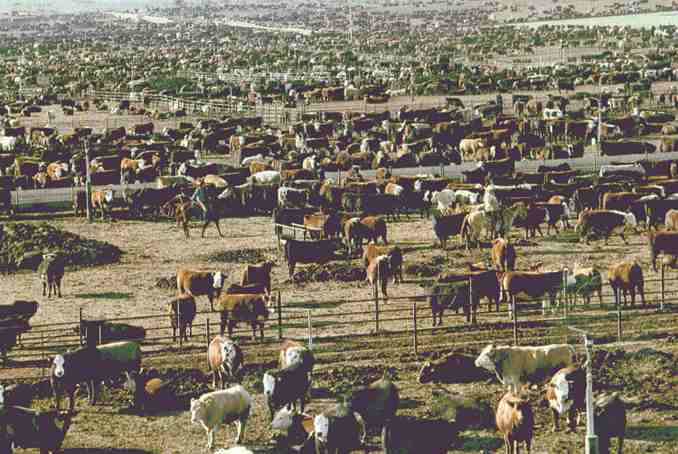Earth's thermostat:
The Greenhouse Effect

(click to enlarge)
PAINTING BY MARK SEIDLER; CONSULTANTS: ROBERT C.
HARRISS, UNIVERSITY OF NEW HAMPSHIRE; ALAN ROBOCK, UNIVERSITY OF MARYLAND
.. ART AND DIAGRAMMES FOR THIS ARTICLE DESIGN: ALLEN
CARROLL; RESEARCH: WENDY CORTESI. LISA R. RITTER, DAVID W. WOOODELL
1. NATURAL GREENHOUSE
As radiation from the sun (yellow) enters earth's atmosphere, a portion
of it is reflected back into space or absorbed directly by the atmosphere.
The 50 percent or so that reaches the ground is converted into infrared
radiation, or heat (red). Clouds and greenhouse gases such as water vapor
and CO2 absorb most of the heat that the earth radiates back toward space.
These gases then reradiate the heat. Over time, the outgoing radiation
balances the incoming.
Other energy (orange) includes latent heat released by formation of
clouds and convective heat carried by updrafts.
2. CARBON CYCLE
The amount of carbon in the earth's atmosphere is regulated by interaction
of air, rock, sea, and all life-forms. Plants, for example, release carbon
to the atmosphere as they breathe and as they decay. They take in CO2 by
photosynthesis and store carbon within energy-rich carbohydrates. Photosynthesis
by plankton, as well as other chemical processes, removes carbon dioxide
dissolved in the oceans -- but an equivalent amount is released by chemical
diffusion and decay of marine organisms.
Carbon is also stored in fossil fuels - the coal, petroleum. and natural
gas remaining from plants and marine animals that died millions of years
ago.
3. HUMAN INFLUENCES
Humans have disrupted the natural carbon cycle by burning fossil fuels
for energy and by clearing forests to feed and house growing populations.
Yearly about 50 million acres of forest are lost to logging, farming, and
pasturage.
Industrial and agricultural emissions raise atmospheric carbon by about
seven billion metric tons a year. Roughly half is absorbed by the oceans
and by vegetation and soils. Emission of greenhouse gases can be reduced,
but no technology is available to remove them once they reach the atmosphere.
FRENCH mathematician Jean Fourier in 1822 compared the earth's
atmosphere to the glass of a greenhouse: Both let the sun's visible rays
enter to warm land, water, plants, and air, yet retard the escape of heat.
His comparison was apt -- in part. Without its atmosphere, the earth would
be as frozen and lifeless as Mars, instead of averaging 15°C (59°F)
and sustaining millions of species. Although the physics of earth's atmosphere
and greenhouse glass are quite different, the term caught on even before
British engineer G. S. Callendar warned in 1938 that human activities were
altering this beneficial greenhouse effect.
What causes this warming, when 99 percent of the atmosphere is
nitrogen and oxygen, neither of which absorbs much heat! Scientists have
discovered that water vapor, carbon dioxide, and other gases -- though
mere traces in the air -- act as powerful heat absorbers. Today the greenhouse
effect stands as well established as any theory in the atmospheric sciences,
anchored by countless measurements from satellites, weather balloons, and
ground stations.
About half of the radiant energy reaching earth from the sun, because
of its short wavelengths, can pass through the atmosphere to the earth's
surface. But the longer waves of heat that radiate back toward space are
absorbed and reradiated by water vapor, carbon dioxide, other gases, and
clouds, and the atmosphere warms. "That's the greenhouse effect," Elmer
had said. "Without it, earth would be frozen -- at least 60 degrees Fahrenheit
colder -- and there would be no more life here than on Mars. But if it
were to increase.... Well, some climatologists say we face temperatures
three to nine degrees higher in the next century."
Back in the last glacial age, some 20,000 years ago, world temperature
averaged about nine degrees colder than today. The carbon dioxide level
was only 190 to 200 parts per million, ancient ice samples from Greenland
and Antarctica show. As the ice melted back, the CO2 level gradually rose
to about 280 ppm by the beginning of the industrial age. "By the middle
of the coming century -- in our children's lifetime," Elmer had said, "the
level will reach 550 or even 600 at its current rate of rise."
The prospect of doubled CO2 -- and even more rapid rise of other gases,
such as methane, which together equal the warming effect of CO2 in the
atmosphere -- is what has atmospheric scientists urgently refining their
computer models of the climate. World population also is predicted to double
by the middle of the next century, from five billion people to ten. And
as all nations become more developed and use more fuel to support those
people, the release of carbon dioxide and other gases to the air is bound
to keep increasing -- despite the care taken or which fuels are burned.
With more warmth and more CO2, some ask, would not more crops grow,
in wider areas than today? Would we not benefit from a warmer world? Perhaps,
in some areas. The more CO2 in the air, the more productive some plants
become. But the biggest unknown is what changes would occur in the planet's
weather patterns. Most climate models show that in some regions -- northern
Scandinavia, Siberia, and Canada, for example -- more rain would fall and
more trees and crops grow. But in today's great mid-continent breadbasket
regions, warming would lead to the drying of soil in summer. Destructive
droughts, such as that of 1988 in North America, would strike more often,
until the Great Plains and Ukraine turn semidesert. Storms such as hurricanes
and tornadoes might become more violent. Forests would decline and change
under the temperature rise, and wild-life would have to migrate -- if it
could -- or perish. The perma-frost under Arctic tundra would thaw, deep
peatlands would decompose, and vast new amounts of carbon dioxide and methane
could be released.
And just as inevitably, as ocean waters warm and expand and the ice
on Greenland and Antarctica melts back, the seas would creep higher onto
the edges of the continents. Large parts of such low countries as Bangladesh
-- already swept by ruinous floods and typhoons -- would be submerged;
cities like Miami, Venice, even New York, would cower behind dikes.
"If a rise of one to three feet, as the models have predicted, seems
extreme," says environmental scientist Stephen Leatherman of the University
of Maryland, "keep in mind that the oceans rose more than 300 feet after
the last ice age -- all in only a few thousand years."
If the ice cap on the island of Greenland were to melt completely, glaciologists
estimate the oceans would rise another 20 feet. Sea level in the eastern
United States has already risen a foot in this century alone, and it is
predicted to go up at least another foot in the century ahead. With that
one-foot rise, Leatherman says, the high-water line at Ocean City, Maryland,
will move inland 100 to 200 feet; in Florida, 200 to 1,000 feet; in Louisiana,
several miles.
Yet paradoxically, say other glaciologists, the huge ice domes on both
Greenland and Antarctica may not be shrinking but growing. The paradox
is that this too may be a sign of global warming. As the atmosphere warms,
it holds more water vapor from evaporation of oceans and soil; hence more
snow falls in the polar regions, hence more ice and possibly lower sea
levels. But the warmer seas eventually will melt back the fringes of the
polar ice, and the oceans will creep inexorably higher.


On the road to understanding sources of methane, scientists
from the National Centre for Atmospheric Research in Boulder, Colorado,
test what tumid out to be an innocent suspect -- fresh asphalt (above).
Wide-ranging research suggests that leaks and venting from coal, oil, and
natural gas production may be underestimated.
Cattle, a known source of methane, are increasing world-wide
-- faster than the human population. The same bacteria that enable a cow
to turn grass into meat or milk cause it to expel methane, roughly 14 cubic
feet a day.


